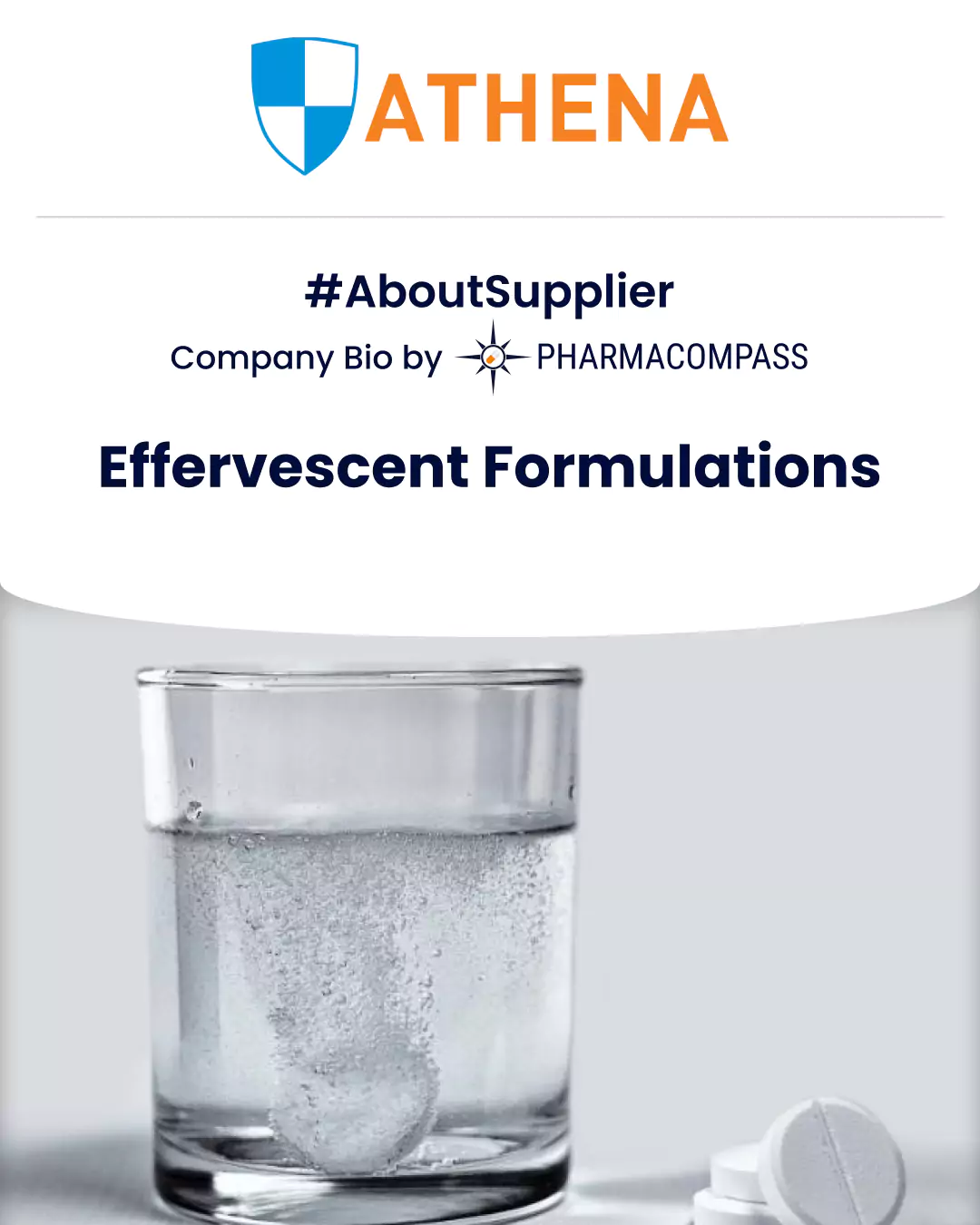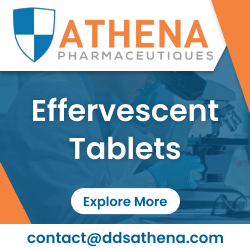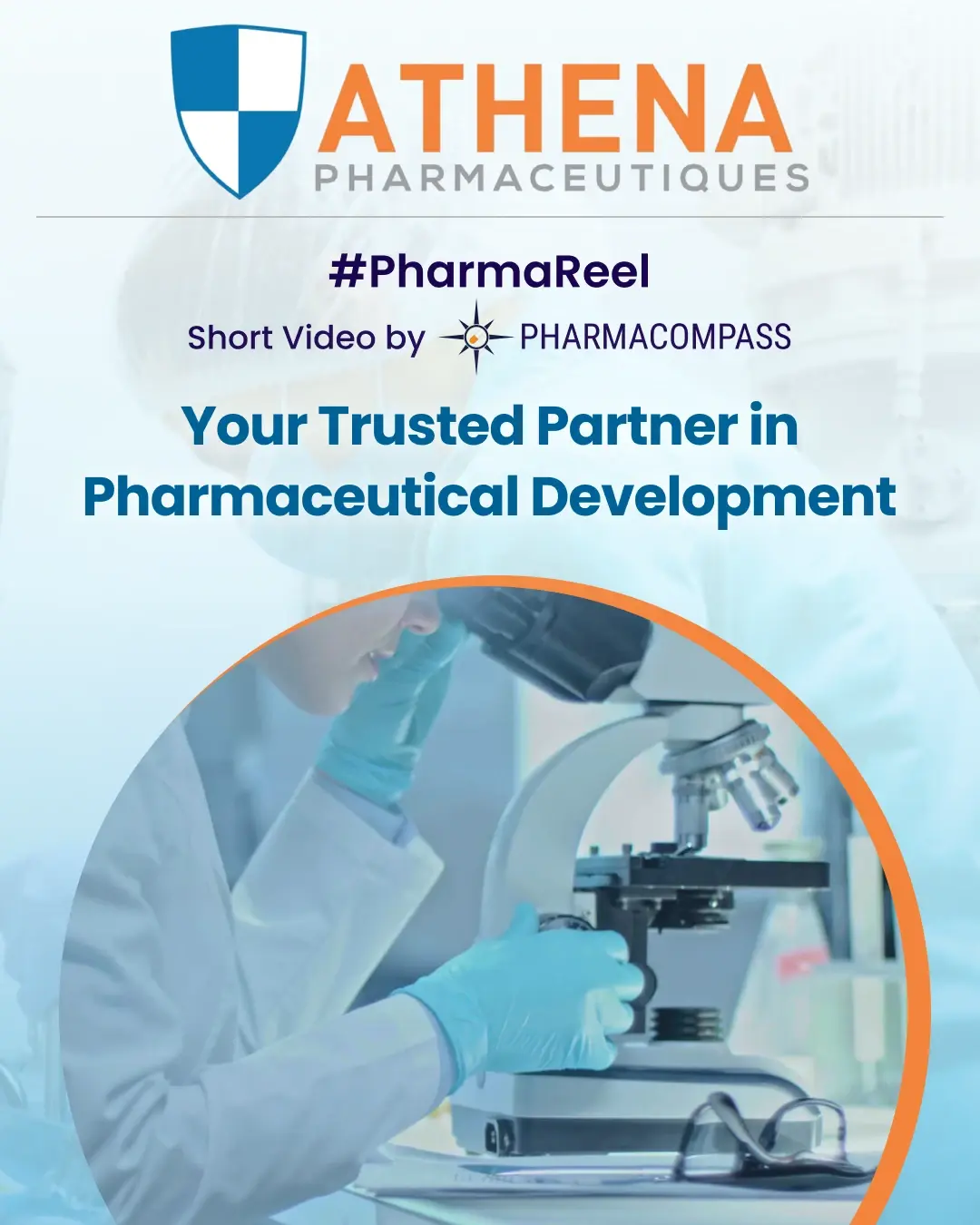
By PharmaCompass
2021-10-12
Impressions: 990
Overview of Athena's oral formulations including effervescent powder, granules & tablets, Oral Disintegrating Tablets (ODT) & more on PharmaCompass.
Q1. What are effervescent formulations and what are the benefits?
Effervescent formulations are produced as oral solid or solid oral forms with the intent of transforming into a liquid just before administration. Solid oral dosage forms are also available in the form of sachets, granules, orally dispersible films, oral disintegrating tablets (ODT), small chewable tablets, oral sticks, etc.
In water, an effervescent reaction produces carbon dioxide – the fizzing that appeals to consumers, along with flavorful additives it provides a multi-sensory experience. Effervescent formulations are thus oral solid immediate release pharmaceutical forms that need to be dissolved in water at the time of administration.
These solid oral dosage forms yield an oral solution or suspension depending on the solubility of the Active Pharmaceutical Ingredient (API). In both cases the Active Pharmaceutical Ingredient (API) is ready for absorption in the gastrointestinal system resulting in a fast onset of action, critical in treating acute symptoms such as pain.
Effervescent dosage forms have been used for many years as an oral drug delivery system and have widespread acceptance in the pharmaceutical and nutritional markets. Effervescent tablets, powders and sachets are widely used oral solid pharmaceutical forms for delivering medicines containing antacids, pain medications, and cough or cold medicines. They dissolve quickly, are stable, convenient and easy to carry.
Effervescent delivery systems can provide a number of patient advantages including:
- Quick absorption of the Active Pharmaceutical Ingredient (API) through fast dissolution
- Faster onset of therapeutic relief
- Multiple applications; dietary supplements, nutraceuticals, herbals, pharmaceuticals
- Easier administration for patients who have difficulty swallowing tablets or capsules
- Accurate dosing even at high drug loading
- Convenient and portable administration
Q2. What are the different types of effervescent formulations offered by Athena?
Athena offers various Effervescent Formulations:
- Effervescent Powder
Effervescent powders are oral formulations composed of active and/or inert ingredient(s), and a mixture of acids and sodium bicarbonate, which release carbon dioxide when dissolved in water. Effervescent powders may be available as sachets or oral sticks.
Effervescent powders are taste masked and thereby increase patient compliance, they are useful for patients who don’t tolerate capsules and tablets well and those who need a high dose of active ingredients to achieve desired therapeutic effects.
- Effervescent Granules
Effervescent granules are granular oral dosage forms or oral formulations of a drug in a dry mixture usually composed of effervescents like sodium bicarbonate, citric acid and tartaric acid. When added to water, the acids and the base present in the effervescent granules react to liberate CO2, resulting in effervescence.
The carbonated water produced from the release of carbon dioxide serves to mask the bitter and saline taste of the drugs. Moreover, the carbon dioxide produced stimulates the flow of gastric juices and helps in the absorption of the medicament.
- Effervescent Tablet
Effervescent tablets are oral formulations designed to break in contact with a liquid such as water often causing the tablet to dissolve into a solution. This makes effervescent tablets the preferred choice of many, including people who are taking tablets medicinally as well as dietary supplements.
Effervescent tablets are used to simplify the handling of doses, provide optimal compatibility, promote superior and rapid absorption, increase a patient's fluid intake and circumvent the difficulty of swallow- ing large pills.
Producing effervescent formulations (effervescent dosage manufacturing) requires conventional solid oral dosage forms manufacturing processes that have been adapted to include additional features because of the unique characteristics of the effervescents. Processes including blending, milling, dry and wet granulation, slugging, roller compaction, fluid bed spray granulation, etc. may be used for effervescent dosage manufacturing.
CDMO for effervescent formulations such as Athena can offer such contract services. Therefore, some companies may choose outsourcing formulation development and manufacturing activities for effervescent materials to contract development and manufacturing organizations (CDMOs).
Q3. What are the fundamentals of effervescent dosage forms?
Effervescent dosage forms consist of a soluble organic acid and an alkali metal carbonate salt, one of which is often the Active Pharmaceutical Ingredient (API). Effervescence is the evolution of bubbles of gas (carbon dioxide) from a liquid as the result of a chemical reaction between the acids and bases present in the effervescent dosage forms.
Effervescent Dosage Forms - Some Common Soluble Organic Acids
- Citric Acid
Citric acid is an odorless, colorless compound which is found naturally in citrus fruits, especially lemons and limes. Citric acid is used as effervescents materials in powders and tablets in combination with bicarbonates. The functions of citric acid in pharmaceuticals include pH adjustment, chelation, stabilization, dissolution/disintegration enhancement, taste masking and enhancement, preservation, etc.
- Tartaric Acid
Tartaric acid is an odourless, colourless, monoclinic crystal or a white crystalline powder with an extremely tart taste. It is one of the most widely distributed plant acids and has a number of nutritional and industrial uses.
Tartaric acid and its derivatives are used widely in pharmaceutical manufacturing. One example is that tartaric acid has been used to make effervescent salts, which when combined with citrate can improve the taste of oral medications.
- Malic Acid
Malic acid is a naturally occurring acidulant and low acid food additive, present in most fruits and vegetables. It is widely used to enhance the flavor and adjust the pH value of alkaline products and to control the growth of bacteria. Malic acid can be used in effervescent formulas for a smoother after- taste, but the price of malic acid is higher than that of citric acid.
Effervescent Dosage Forms - Some Common Alkali Metal Carbonate Salts
- Sodium Bicarbonate
Sodium bicarbonate is a primary ingredient in effervescent tablets and powders. Together with an acid, such as citric acid or tartaric acid, sodium bicarbonate reacts in the presence of water to produce carbon dioxide. The carbon dioxide leads to the resultant fizzing of the effervescent powder, such as seen with Alka-Seltzer.
- Sodium Carbonate
Sodium carbonate is the sodium salt of carbonic acid. Sodium carbonate is also known as sal soda, washing soda, soda ash and soda crystals. Sodium carbonate is commonly used in chemical reactions in the pharmaceutical industry as part of acid-base reactions.
Sodium carbonate has a lower percentage of carbon dioxide as compared to sodium bicarbonate which makes it more stable in comparison.
- Potassium Carbonate
Potassium carbonate is a white powder or a colorless solid crystal which has a salty taste. Also known as potash or pearl ash, it may be used in pharmaceutical laboratories as a drying agent or as a source of potassium. Potassium carbonate is found in effervescent tablets. Furthermore, potassium bicarbonate may also be used as a base in effervescent formulations.
Q4. What are the different excipients used in effervescent systems?
Various effervescent excipients are used in formulating effervescent pharmaceutical forms such as powders and tablets. Some of these effervescent excipients and the roles they play are noted in detail below.
- Binders
Binder excipients are formulated to act as an adhesive to literally “bind together” powders, granules and other dry ingredients in order to impart mechanical strength to the product. Binders are normally necessary in effervescent formulations such as tablets to bring the tablet hardness to a point where handling is possible. Binders used in effervescent tablets manufacturing should be water soluble.
- Lubricants
Lubricants are pharmaceutical excipients added in small quantities to tablets, small chewable tablets, and capsule formulations in order to reduce friction and improve certain processing characteristics. A perfect lubricant (or auxiliary agent, in general) for effervescent products must be water-soluble, non-toxic and tasteless.
- Plasticizer
Plasticizers are used mainly for solid oral forms including effervescent tablets that are film coated. The rate of effervescence can be modified with the use of a plasticizer. Basically, increasing the amount of plasticizer prolongs the rate of effervescence.
- Coloring agents
Colorants or coloring agents are mainly used to impart a distinctive appearance to pharmaceutical dosage forms such as small chewable tablets, oral disintegrating tablets (ODT), coated tablets and capsules. Coloring agents may be used in effervescent formulations to enhance their appearance, ultimately increasing patient compliance.
- Flavoring and sweetening agents
Small chewable tablets, oral disintegrating tablets (ODT), oral sticks, sachets and effervescent tablets need flavours and also sweetening agents to improve acceptance and increase patient compliance. Other effervescent excipients may include complexing agents (cyclodextrins), glidants, fillers, etc.
Q5. When does it make sense to outsource the production of effervescent materials to a Contract Development and Manufacturing Organization (CDMO)?
In the pharmaceutical industry, the advantage of outsourcing manufacturing and pharmaceutical development services (e.g. effervescent materials production) is that it allows pharma companies to focus on their core business, such as R&D and marketing, which can crucially reduce costs, time-to-market, and risk.
Some Reasons for Outsourcing Formulation Development and Manufacturing Activities:
- Cost Reduction
Outsourcing operations to CDMOs, CROs and CMOs reduces drug product development and overall costs, thereby improving net earnings and cash flow. Outsourcing also makes it cheaper and faster to conduct research, increases the efficiency of manufacturing processes and allows pharmaceutical and biotechnology companies to divert resources to focus on other areas, such as marketing.
A specialist CDMO such as Athena can offer manufacturing and pharmaceutical development services, which help customers focus on financial drivers and put resources in place to rapidly move new products forward.
- Quality Assurance
Athena (Contract Development and Manufacturing Organization) as has well established quality checks which are continuously upgraded over the years. It ensures that pharmaceutical products are manufactured in accordance with existing quality standards. Specialist CDMOs can thus offer specialized services for ensuring quality assurance.
- Regulatory Support
Contract manufacturers, CDMOs, CMOs, etc. have a good understanding of the pharma industry and FDA – health authorities’ activity, which they develop through years of experience. They can handle a project from start to finish, identify flaws and spot potential risks to quality agreements via regulatory intelligence monitoring throughout the supply chain. They thereby offer regulatory specialized services.
Some other benefits of pharmaceutical outsourcing to CRO, CMO and CDMO (Contract Development and Manufacturing Organization) facilities include access to specialized equipment, technical expertise, accelerated time to market, etc. However, cost reduction is the primary reason why most companies choose to outsource their development and manufacturing activities to specialist CDMOs.
CDMO for Effervescent Formulations
A specialist CDMO for effervescent formulations such as Athena supports you across the entire pharmaceutical value chain - as a reliable and experienced partner. It offers various contract services encompassing formulation development and effervescent dosage manufacturing (e.g. effervescent tablets manufacturing).
As noted above, outsourcing to a CDMO for effervescent formulations will ensure quality assurance and regulatory support, while reducing costs and building capacities in other areas. Choosing a CDMO for effervescent formulations (e.g. powders and tablets) that can support your project is important.
Assessing outsourcing formulation development and manufacturing capabilities and contract services (e.g. pharmaceutical development services, specialized services, effervescent tablets manufacturing) offered by the CDMO for effervescent formulations can help a partnering company make the right decision.
The PharmaCompass Newsletter – Sign Up, Stay Ahead
Feedback, help us to improve. Click here
Image Credit : Biosynthesis, tech advancements by PharmaCompass is licensed under CC BY 2.0
“ The article is based on the information available in public and which the author believes to be true. The author is not disseminating any information, which the author believes or knows, is confidential or in conflict with the privacy of any person. The views expressed or information supplied through this article is mere opinion and observation of the author. The author does not intend to defame, insult or, cause loss or damage to anyone, in any manner, through this article.”






